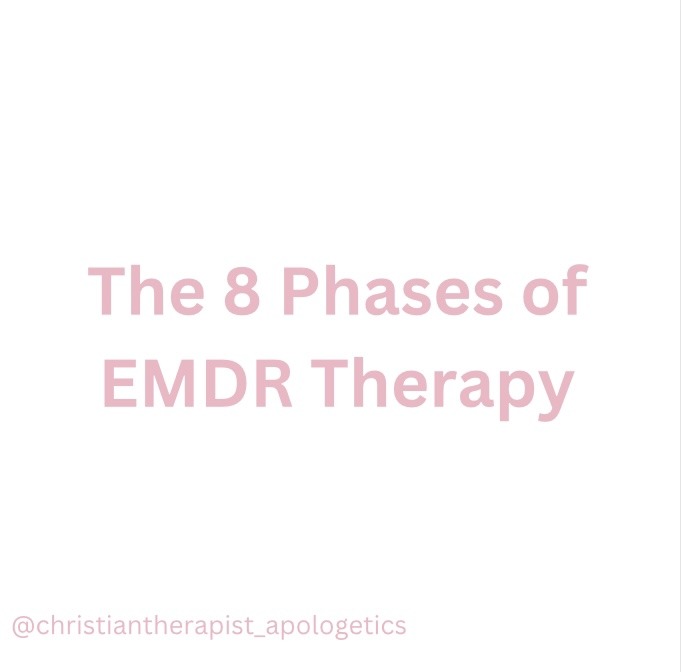EMDR therapy is a popular and effective approach for treating trauma and PTSD symptoms. If you are struggling with trauma wounds and have been curious about EMDR and what it entails, this blog is for you.
In this post, I will discuss the 8 phases of EMDR therapy.
Phase 1 of EMDR Therapy: History Taking and Treatment Planning
Not everyone will benefit from EMDR therapy. Therefore, the therapist will spend time assessing whether or not you are appropriate for EMDR. A factor in EMDR readiness is good therapeutic rapport. For example, the client needs to feel comfortable to be vulnerable and truthfully discuss what is happening in their EMDR experience. Also, the client needs to feel able to reach out for support if needed.
History Taking
The history-taking phase is where the therapist learns all about your presenting issue. You and your therapist discuss what has brought you into therapy. Your therapist will ask you about your symptoms, triggers, and when those symptoms started. Also, you will discuss your desired outcome from treatment.
Treatment Planning
You and your therapist will create a treatment plan. A treatment plan will outline how you will reach your therapeutic goals. It will include your goals, objectives- how you will meet your goals, and interventions- the therapist’s treatment modalities.
Three-Pronged Approach
The three-pronged approach in EMDR treatment planning targets the past, present, and future. You will work with your therapist to determine past events that contributed to your present-day issues. Then, there will be a focus on the present-day triggers that hinder your ability to function. Lastly, you will focus on your ability to make new choices in the future.
Now that history has been gathered, preparation begins.

Phase 2 of EMDR therapy: Preparation
When an individual has experienced trauma(s), their window of tolerance- the ability to cope with difficult emotions- shrinks. The preparation phase of EMDR provides coping skills and tools to regulate difficult emotions.
When engaging in phase 4- desensitization, you most likely will experience intense emotions, images, feelings, and body sensations. Therefore, tolerating and coping with intense emotions is essential when reprocessing trauma.
Two skills taught in EMDR preparation Phase
There are many skills and tools taught in this phase. However, I will share just two of the most common skills taught. The skills below are a way for you to be able to state change. State change is the ability to shift from an upsetting state to a more calm and positive state.
Containment Exercise
In the containment exercise, you learn how to put away disturbing material through visualization. The therapist will ask you to visualize a container that opens and closes. Then, once you have the container in mind, the therapist will walk you through a visualization. In this visualization, you will imagine putting away any disturbing thoughts, images, feelings, and body sensations into this container. Lastly, you will visualize putting this container away until the next session.
The containment exercise helps end a highly emotional session. However, you can use it as a coping tool outside a therapy session.
Calm/Safe place
The calm/safe place is a visualization of a real or imagined place; that gives you a sense of calm, peace, and safety. This exercise introduces bilateral stimulation (BLS) via eye movements, tapping, auditory, or visual. Therefore, you will be able to determine what form of BLS works for you.
In this exercise, you will imagine being in this calm/safe place, and if it continues to feel positive, the therapist will start the BLS. The BLS will strengthen the positive feelings associated with this place. BLS in this phase will be slow and short sets.
In my blog, A Simple EMDR Therapy exercise to Ease Anxiety, I walk you through the calm/safe place visualization.

Phase 3 of EMDR therapy: Assessment
In phase one and throughout therapy, you and your therapist should have established trauma memories to target and process. The assessment phase will set up the first target to process.
The assessment phase consists of several steps. First, you select the issue to target. Second, you imagine a picture that represents the worst part of the experience. Third, you identify a negative belief you have now when thinking of that picture. Fourth, you will choose a positive thought you would like to have when bringing up the image. Fifth, you will communicate emotions and body sensations you are experiencing when thinking about the issue. Lastly, you will rate your level of distress on a 1-10 scale, with 10 being the highest disturbance.
After the assessment phase, you are ready to process the trauma.
Phases 4, 5, and 6 of EMDR therapy: Desensitization, Installation, and Body Scan
Desensitization
The desensitization phase is when you will reprocess trauma memory. The goal is to reduce the disturbance to zero on the level of distress scale mentioned in phase three. Depending on the trauma, zero may not always be possible. The BLS in this phase will be faster and longer sets.
Your therapist will ask you to focus on the image, the negative cognition, emotions, and body sensations experienced. The therapist will then start BLS. As the BLS begins, you will notice whatever happens.
The therapist will stop after several sets and check in. At the check-in, you will give a brief and concise report of what you notice. Your therapist will then say notice that, and the cycle will continue until the level of distress is zero.
Installation
Once your distress level is zero, you move to the installation phase- increasing the strength of the positive cognition (PC). BLS is used to strengthen the PC picked from the assessment phase. However, you can choose another PC that is more fitting.
Body Scan
A body scan helps detect if any disturbing material exists in the body. You will bring awareness to the different parts of your body-head to toe. If there is a disturbance, there may be another memory to target.
The body scan phase is complete when you report no disturbing body sensations while focusing on the target and PC.
BLS is used to strengthen reported positive body sensations.

Phases 7 and 8 of EMDR therapy: Closure and Reevaluation
Closure
When trauma reprocessing is complete, you may experience continuous processing during the week. Therefore, your therapist will review tools to ground and engage in coping skills.
Sometimes a trauma memory takes several sessions to complete. Therefore, your therapist will support you in grounding at the end of the session.
Reevaluation
After completing trauma reprocessing, your therapist will check in at the next session to see if there has been a resolution to your trauma memory.
First, your therapist will ask you about the week and what you noticed. Then, you will bring up the target memory and rate the same 0-10 scale how disturbing it feels. If above a zero, you will engage in more processing. You will move on to the next target if you report no more disturbance.
Online EMDR Therapy in Colorado and Florida
If you have experienced a traumatic event and feel stuck from its impact- EMDR therapy might be right for you.
Amanda Conroy specializes in PTSD treatment/ Trauma therapy. Schedule a free 20-minute phone consultation today.
Other Online Counseling Services offered in CO and FL


